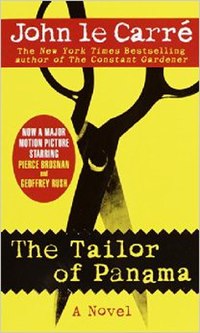The Tailor of Panama
by John le Carre
Harry Pendel is a British expatriate living in Panama City and running his own successful bespoke tailoring business, Pendel and Braithwaite. His wife and children are unaware that almost every detail of his life is fabricated, including his former partner, Mr Braithwaite. In reality, Harry Pendel is an ex-convict who learned tailoring in prison.
Andy Osnard is a young British MI6 agent sent to Panama to recruit agents to gather intelligence and protect British trade interests through the Panama Canal. However, Andy has his own agenda and, after he discovers Harry's past, sees the perfect opportunity to recruit a new agent and embezzle money from the British government.
Concocting a fictitious network of revolutionaries, known as the silent opposition, Harry, through Andy, manages to attract the interest of the British secret services and even the US government. However, Harry has used his own friends as the basis for his fantasies, and as the plots are taken more seriously they become known to the Panamanian authorities and Harry struggles to cope with the guilt of setting them up.
Harry's wife, Louisa, becomes suspicious of the amount of time he spends with Andy and suspects that Harry is having an affair. She breaks into his office and discovers all his fantastic lies.
Harry's friend, Mickie, kills himself rather than face the risk of going back to jail, and Harry helps dispose of the body, making it look like he was executed. As Mickie is the supposed leader of the silent opposition, the British and US governments use this as an excuse to topple the current Panamanian government.
At the end of the book the US military has begun another invasion of Panama, based largely on Harry's fabrications, and Harry watches the destruction from the window of his house.
The name of Harry's firm, Pendel & Braithwaite, might have been inspired by a plot device in the movie, Ministry of Fear, also based on a Graham Greene novel, which takes place on the premises of a bespoke tailoring firm, Travers & Brathwaite.
